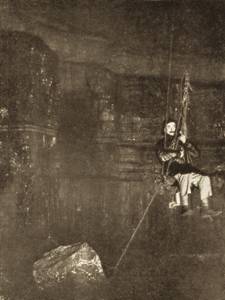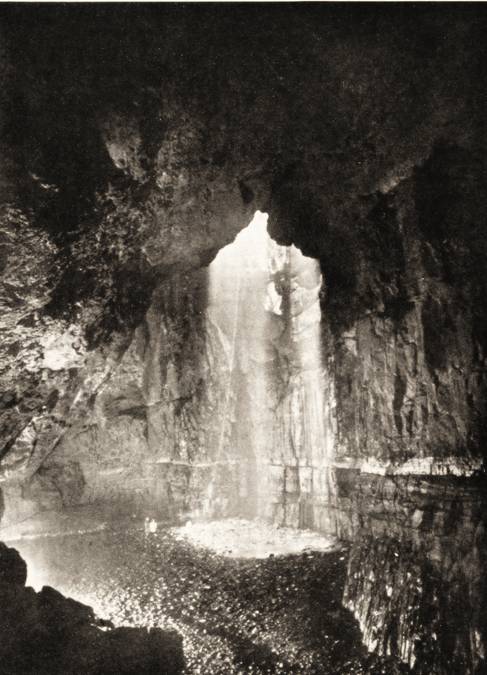Gaping Ghyll By The Main Shaft Again
An early May Whitsuntide, and on the whole once more a fine one. The feature of the Meet of 1921 was the creation, by the devoted labours of the Sub-committee, during four or five very strenuous week-ends, of an entirely new line of descent in the far corner of the Main Shaft, suggested and largely worked out by the two Burrows.
The plate shows the whole apparatus very clearly, the key to the position being a crack in the corner breaking through a ledge which supported the beams and, when cleared of grass and earth, made a highway to the corner.
The “victim ” walked along the ledge secured by a rope over a pulley above, descended a few steps on the ladder in the crack with his back against the rock, stepped into the chair, and secured his belt to it before releasing the rope. Landing on return was particularly convenient – people could be actually pulled up to the level of the beam – and in full daylight. The views on the journey were even more superb than along the line from the Jib Tunnel. The first man down and the last up have not the advantage of the guy-line, and the wire rope then touches the rock in several places.
An event we must not fail to notice, and with regret, is the removal of that staunch supporter of the Club, Mr. William Metcalfe, from Clapdale Hall. Hence the moving spirit of these expeditions, J. H. Buckley, met with enormous difficulties in arranging the sledge transport, and we are afraid the Y.R.C. does not wholly realise the extent of his triumphant success. A number of men reached camp on Friday, 13th May, An early party of three descended Car Pot, and later in the evening the next little pot-hole, Nettle Pot, a very amusing problem. It is rumoured that in July another party found themselves too massive to enter Car Pot.
Saturday’s operations were delayed by the necessity of removing some large loose blocks close above the beams, and Seaman’s successful performances with a sledge hammer from the shaky stance of a ladder rung were a great delight. That these had not been noticed and removed is put down to their being solid enough a week before and to the accident of the earthquake. Heavy rain in the afternoon caused all traffic to be suspended after two trips to fix telephone and guy-lines.
On Sunday, Jack Buckley and E. E. Roberts repeated the Booth-Parsons crawl of 1903 from the East to the South Passage (Y.R.C.J., Vol. II., p. 50). Time, one hour and a quarter from the telephone via East Passage to a candle placed at the junction with the South. The entrance is obvious, five yards to the right of where one scrambles into the East Passage, more obvious than the main route. First you climb down through boulders to a stiff 15 feet pitch into a small chamber, from which lead two parallel passages, right – a flat crawl, left – a hands and knees tunnel. In 10 yards a cross-over tunnel is useful, as the left-hand man cannot continue beyond the point at which he can see his comrade to the right. All the way the old string and the marks in dry silt of 18 years ago remain perfect. This passage is in fact that entered by Calvert, Booth, and Gray in 1896, the first tried in Gaping Ghyll (see Y.R.C.Journal, Vol. I., p. 126), and the parallel passages are indicated in their plan.
The rest of the journey is an amazingly flat crawl with hopeless prospects, and the question arises – if Booth and Parsons had the determination to push on, at how many points have their successors missed discoveries, and turned back through lack of the same determination?
Later the West Chamber was visited; the descent is overhanging but only about 10 feet deep. No exit could be found, though the statement has undoubtedly been made that a way was once found to the canal in the Pool Chamber. The next visitors should make a more thorough examination of certain holes high up at the far end. There is any amount of choice, along the sides, of chances for the digger.
On Monday, Hudson, Ellis and Roberts laddered the Mud Chamber and went to the end of the East Passage. The impression that one can walk or climb into the Mud Chamber is wrong. The place is still as described in Y.R.C. Journal, Vol. I., viz. – A mud traverse and short climb to a mud ridge between a very deep hole and the main Mud Chamber. This traverse, unroped, is no longer safe. Below the ridge is a dry mud slope finishing in a vertical drop (one ladder) to the head of the scree slope in the Chamber. Steadied by the ladder line, it is easily possible for the last man to come down and hold his men from the top of the ladder.
The ascent of 130 feet up the opposite scree slope is extremely impressive, and the further reaches of the passage are very remarkable, particularly the startlingly abrupt finish. The next party should carry plenty of rope, so as to be able to explore the second big chamber, which is passed high up on the side. Very obvious things could easily have been missed in such a place, and may await some happy explorer.
Most parts of the South Passages were also visited, and the Belfry at the head of the Stream Passage into the Stream Chamber again reached. There appears to be a prospect that another exploration in the lowest part of Stream Chamber may open out fresh ground.
Thirty members and friends were in camp, 44 descents were made in two days, and camp cleared on Tuesday.
Nick Pot was descended on that day and proved to be very wet, with a ladder pitch of not more than 25 feet.
E. E. R.


